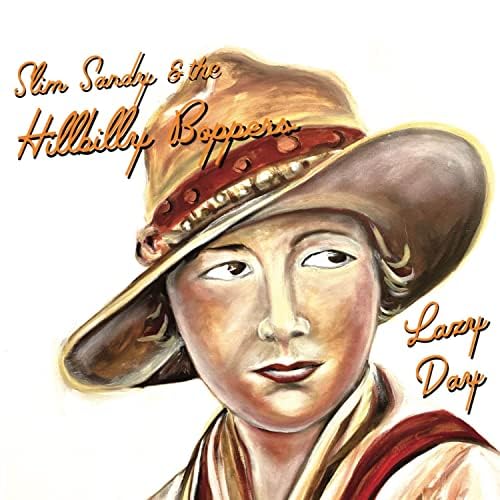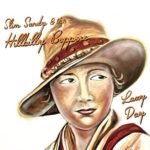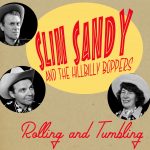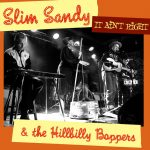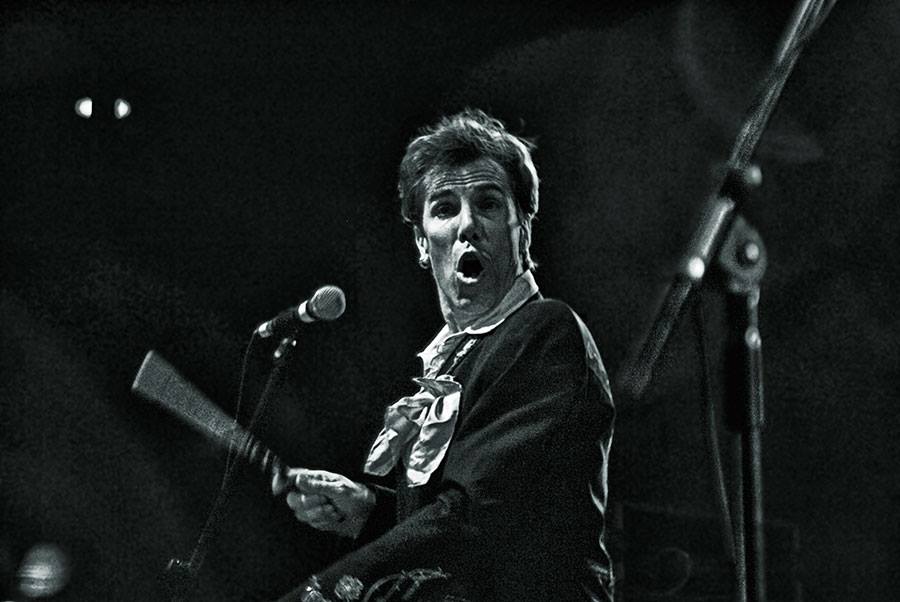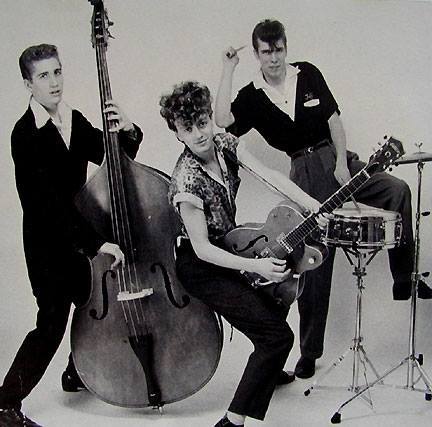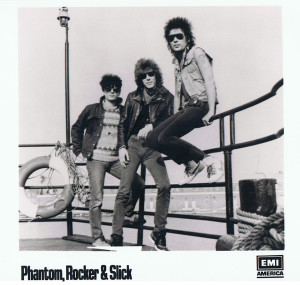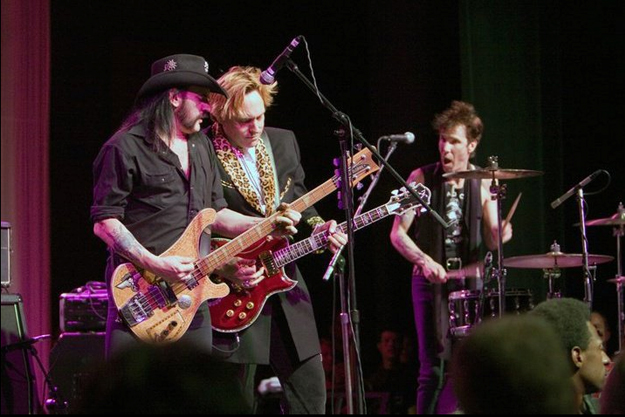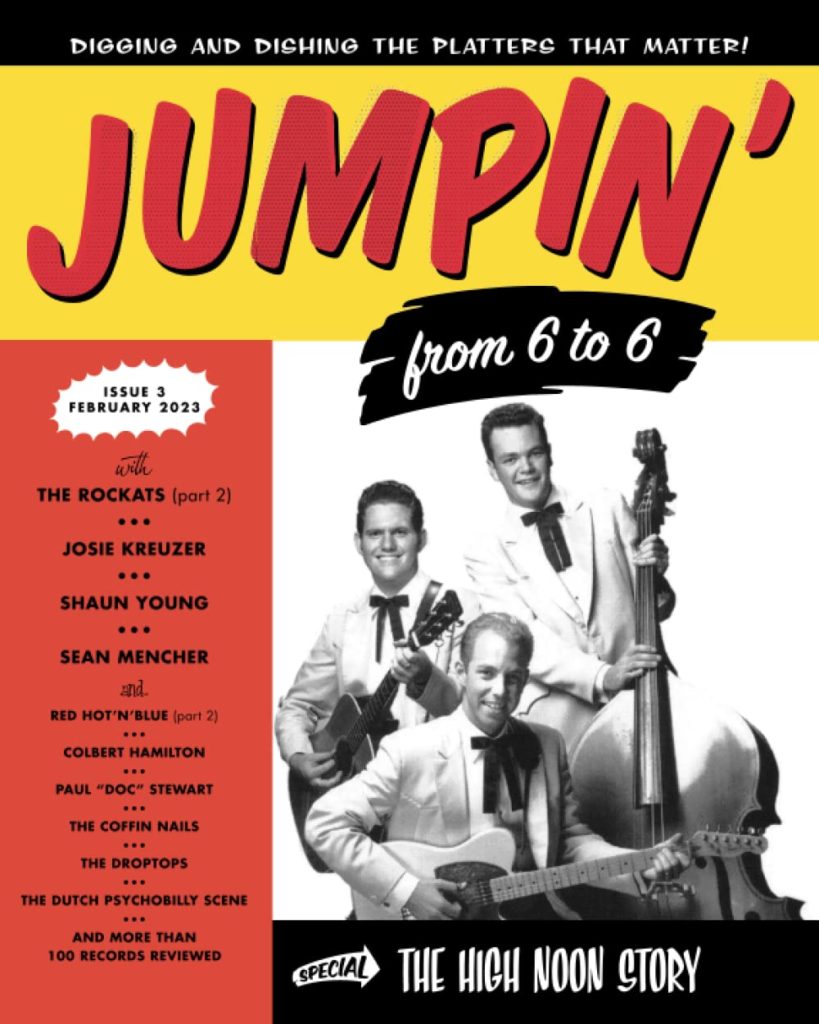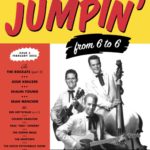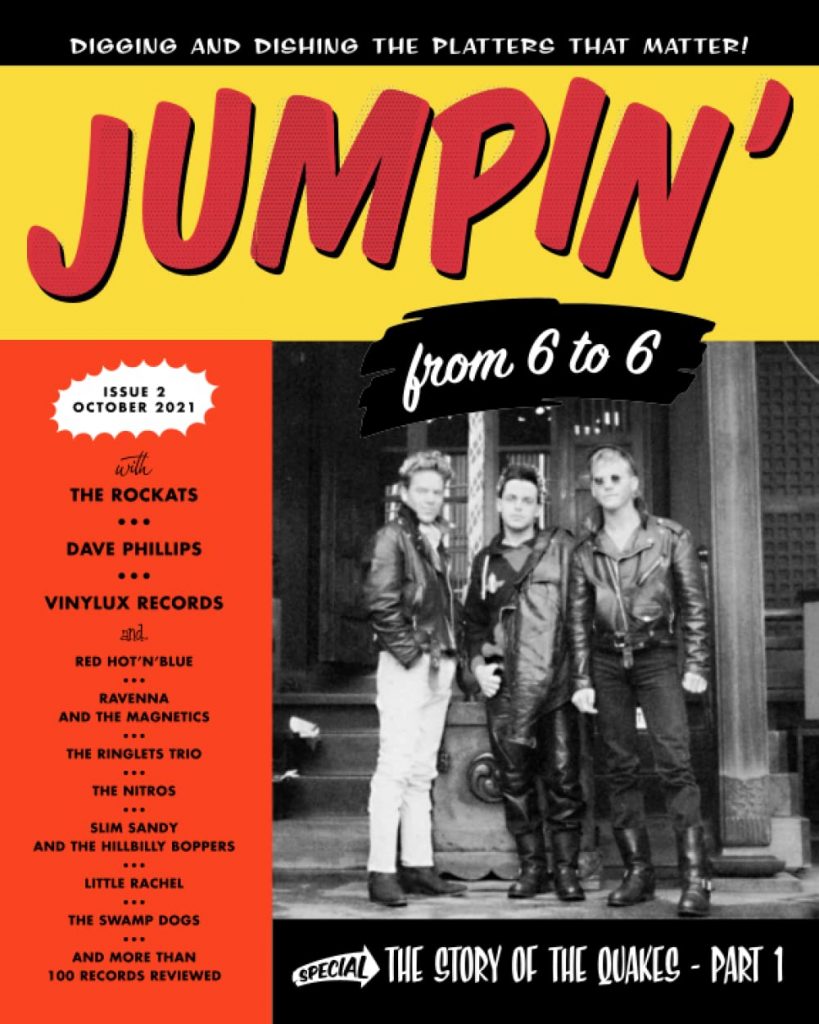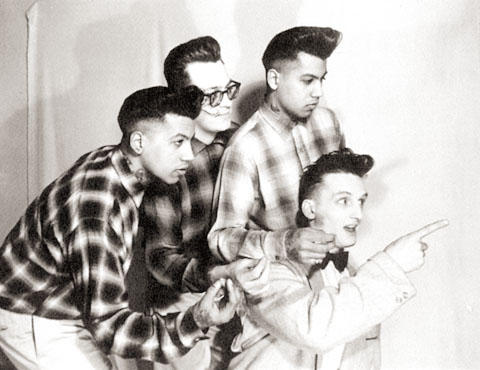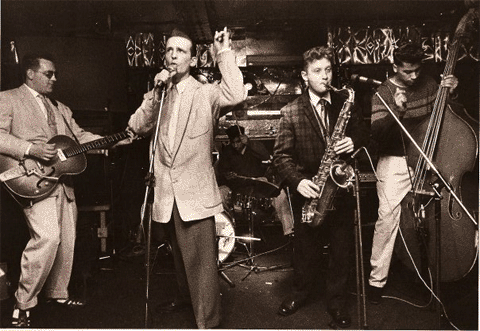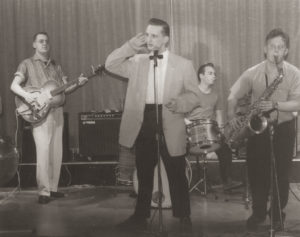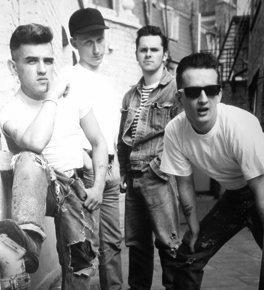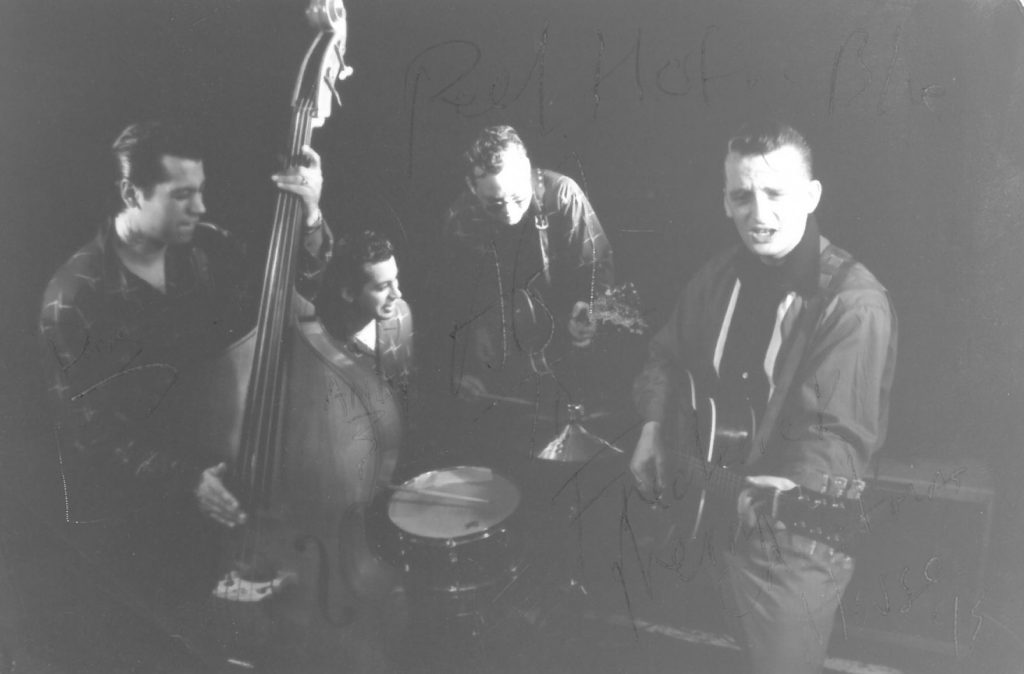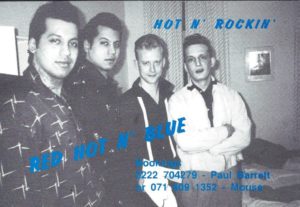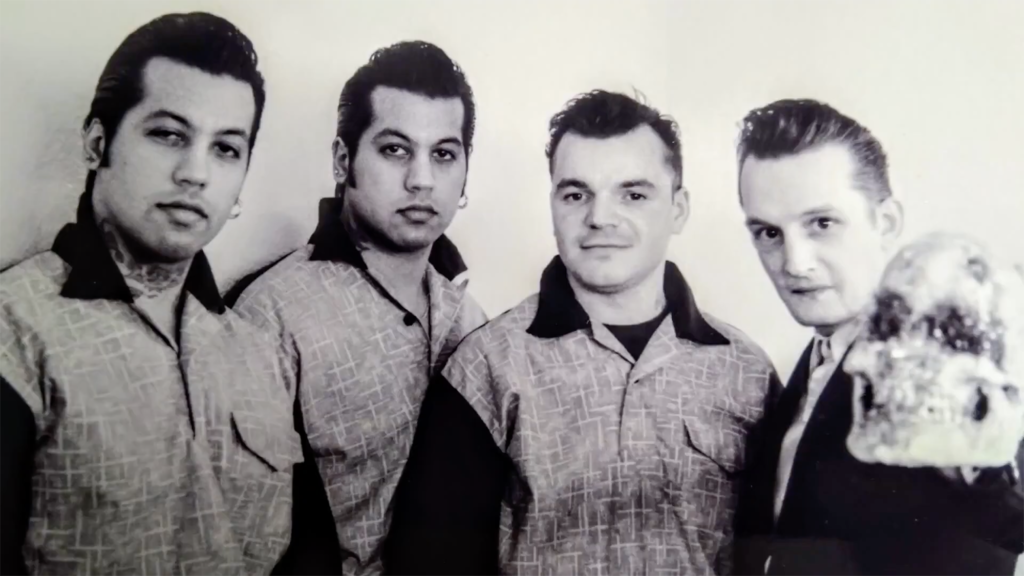Slim Sandy and the Hillbilly Boppers – Lazy Day
Self-released [2023]
Lazy Day – Teardrops From My Eyes – I Hear You Talkin’ – Jack’n’Jill Boogie – Havin’ A Party – Buster’s Dream – I Got A Feelin’ – Goin’ Back Home – Dreamin’ Of You – Meet Me By The Moonlight – I Heard The Bluebirds Sing – Foolin’ Round – Up Above My Head – Kiss The Baby Goodnight
There’s no greater pleasure than being surprised by a band or an artist you know or think you know well. I’ve been following the musical adventures of Peter Sandmark (Slim Sandy) since I bought my first Ray Condo record a long time ago. His musical journey then took me to discover the Crazy Rhythm Daddies and Slim Sandy as a one-man band, with a detour to the Howlin’ Hound Dogs, for whom he played drums.
In recent years, he has formed with Willa Mae, his partner, the excellent and prolific Slim Sandy and the Hillbilly Boppers. They released many albums, each better than the other. The group has developed a very personal style of rural bop based on hillbilly, pre-war blues and a whole host of different influences. After a while, I came to almost take the band for granted. To me, it went without saying, something like, “Ah yes, another Slim Sandy album, I bet it’s going to be good.” And it was.
And Lazy Day has arrived. Something was different. The first visual impression gave me a clue: the cover was painted by Trace Nelson (aka Willa Mae) and not designed by Slim Sandy.
Finally, I put the disc in the player and what a joy, my friends. Lazy Day is more than just another excellent Slim Sandy album. Of course, it contains all the elements mentioned above that make their records successful, but with subtle differences. The trio Slim Sandy, Willa Mae, and Soda Pop welcome back Tom Hammel, already present on the previous album, on steel guitar. The band has added the services of Doc Mancini on double bass, which gives a fuller sound to the Hillbilly Boppers, taking the band towards an earlier Western-swing style, as in this cover of Cindy Walker’s I Hear You Talking.
It also allows Willa Mae to fully concentrate on singing. This is one of the significant differences from previous recordings. Of the fourteen songs, Willa Mae takes the vocal lead on half and is present either singing harmonies or duets on the remaining seven. The current scene lacks too many good female singers not to rejoice at this news. I’ve said it before in my previous reviews of the band; I love Willa Mae’s vocals. She sings with a disconcerting simplicity and naturalness, contributing to the group’s closeness. There is no effect, no pose. But be careful; simplicity does not mean poverty; quite the contrary. This remark is also valid for the group. The instrumentation seems simple. But this is only an appearance. Soda Pop may only play with a snare drum, but he’s always perfect and the perfect illustration of “less is more”.
Similarly, Tom Hammel adopts a simple style, close to the early/proto-western swing combos. Here, no glitz or Speedy West accelerations that would be out of place, but a stripped-down style that serves the song. And behind all that, we hear Slim Sandy’s guitar swinging like there’s no tomorrow. Its discreet presence is the architecture that holds it all together. There may only be four musicians, but each occupies a well-defined space that gives the impression that there are many more.
The repertoire gives pride of place to Charlene Arthur with no less than three covers (I’m Having A Party All By Myself, Kiss The Baby Goodnight and Dreamin’ Of You), but there is also a bluegrass waltz (Meet Me By The Moonlight), a gospel (Up Above My Head), a fantastic cover of Big Maybelle’s I Got A Feeling, and of course lots of Hillbilly bop. But for me, the song that stands out is their cover of the Canadian hit I Heard the Bluebirds Sing by Hod Pharis and Anne Little, then covered by the Browns, Jim & Jesse, Marty Robbins… There is in their version a freshness, simplicity and obviousness that makes the listener find themselves pressing the “repeat” button repeatedly. This feeling of closeness with the music and the group is one of the great qualities of the Hillbilly Boppers.
I often end up adding something like “I highly recommend this disc” or “Don’t wait to get it” at the end, but if at this point in the review, you haven’t understood that this album is essential, so all I have to do is go to the far North and become a trapper.
It’s available on all digital platforms or go to https://slimsandy.wordpress.com/ to get a physical copy.
Fred “Virgil” Turgis
Slim Sandy and the Hillbilly Boppers – Rolling and Tumbling
Crow Matic Records CR-014 [2021]
It Ain’t Right – Ice Water – Jack’n’Jill Boogie – Whatcha gonna do When There Ain’t No Swing – Hit That Jive Jack – I Hear You Talkin’ – Meet Me At the Moonlight – Hillbilly Fever – Gettin’ that Lowdown Swing – Rompin’ and Stompin’ -Rolling and Tumbling
The latest Slim Sandy and the Hillbilly Boppers is made of the same combination of hot rustic bop, hokum, jug band and hillbilly harmonies as the previous ones. However, there are some differences in the mix.
More than half of the tracks feature the great Tom Hammel on steel guitar. Hammel and his instrument really bring something unique to the band. Also, you’ll hear a double bass played by Clark Brendon on a couple of tracks. It’s not that I dislike Willa Mae’s washtub bass, far from that, but having a double bass deepens their sound and brings diversity to the set. One will hear an excellent bluesy rendition of I Hear You Talkin’ sung by Willae Mae among these tracks.
There’s also a great gospel with the Carter Family’s Meet Me At The Moonlight.
Gettin’ That Lowdown Swing and Rompin’ and Stompin’ were recorded with French musicians, namely Bombo Lolo Tongo on steel, Colada Jones on piano and Max Genouel on guitar. The band goes for an early Western Swing style that suits them perfectly on these tracks. I’d really be curious to hear them try stuff with a horn or a clarinet a la Arnett Nelson.
This is the great talent of Slim Sandy and his band. Despite a somewhat limited arsenal, they always proposed something new and exciting, whether by finding new ways to play old songs or adding guest musicians.
Fred “Virgil” Turgis
Slim Sandy & the Hillbilly Boppers – It Ain’t Right
Crow-Matic Records [2021]
Ice Water – Sweet Love On My Mind – It Ain’t Right – Sag Drag And Fall – Hillbilly Fever
Each new Slim Sandy and the Hillbilly Boppers is like reuniting with old friends. You’re always happy to meet them. Or it’s like turning the dial of your radio and hearing an old familiar voice, like the old-time radio shows.
Keeping the same approach with no concessions to trends or modernity, the trio, augmented here by the excellent Tom Hammel on steel guitar, rips through five hot numbers that are sure to give you the Hillbilly fever.
Glenn Barber’s Ice Cold Water seems tailored-made to received the Hillbilly Boppers’ treatment with Slim and Willa Mae singing harmonies like Jimmy and Johnny. Which led us to Sweet Love On My Mind. The Hillbilly Boppers’ version owes more to their version than Johnny Burnette.
Stuff Smith’s jazz/jive classic It Ain’t Right was already played by Slim with the Crazy Rhythm Daddies. I suspect their version to be also inspired by the Washboard Wonders, who recorded it on Bluebird in 1936. Anyway, Slim Sandy and the band turn it into a hillbilly/jug number, with perfect harmonies.
Their cover of Sid King’s Sag Drag and Fall proves how comfortable they are with bands having one foot in country music and the other in Rockabilly.
Hillbilly Fever (Little Jimmy Dickens) is another perfect vehicle for the band.
As for the previous release, this one is very joyful, exciting and as I said, they have something amicable in their music.
This one and the other albums can be found on Spotify, iTunes, Amazon and all musical platforms.
Also pay a visit to the band’s website at
https://slimsandy.wordpress.com/
Fred “Virgil” Turgis
Slim Sandy & the Hillbilly Boppers – Done Gone!
Crow-Matic Records 2018
Done Gone! – Chicken Shack Stomp – Romp and Stomp – I’ve Got the Boogie Blue
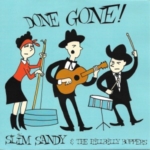
Though tempting, it’s not always evident, nor fair, to compare one band to another to describe its music. You can give a vague idea, but you can also fail to describe the band’s personality. And you can’t deny that Slim Sandy and the Hillbilly Boppers have tons of personality. Album after album they created their style and no contemporary band sounds like them.
If you ever asked yourself (be careful, it’s here that I slip the comparison) “What if the Delmore Brothers had recorded a session with the Cannon’s Jug Stompers?” I guess that the result would be quite close to Slim Sandy and the Hillbilly Boppers’ latest ep.
The title track is pure hillbilly yet rocking at the same time. Chicken Shack Stomp is in the same vein and features Mike Sadava on steel guitar. Both are sung by Slim Sandy.
The B-sides opens with Romp and Stomp. Willa Mae and Slim Sandy sing harmony vocals on that one. I wrote it in previous reviews but let me say it again: Willa Mae is a real plus to the band with her mastery of washtub bass and her contribution to the vocals. This is confirmed by Charlene Arthur’s I’ve Got the Boogie Blues on which she sings lead.
All in all, Done Gone is an excellent ep that encompasses the sound of the band perfectly. The vinyl adds to the beauty of the thing, especially with a cover drawn by Slim Sandy/Peter Sandmark.
Fred “Virgil” Turgis
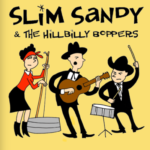 Slim Sandy & the Hillbilly Boppers – Boogie Woogie Fever
Slim Sandy & the Hillbilly Boppers – Boogie Woogie Fever
Crow-Matic Records 2018
Done Gone – I’ve Got the Boogie Blue – Boogie Woogie Fever – Romp and Stomp – Chicken Shack Stomp – Buster’s Dream – Everybody Loves My Baby – It’s All Your Fault – Hillbilly Ball – Crazy Bout You – No Good Daddy – Saturday Night Fish Fry
I was still catchin’ my breath and restin’ my feet after listening repeatedly to “Getting That Low Down Swing” that “Boogie Woogie Fever” arrived in my letter box. Slim! Dont you have no pity? Anyway, my feet will rest later. This new album contains twelve songs including four by Peter Sandmark/Slim Sandy. They mix hillbilly, western swing (hence the return of Mike Sadava on steel for three tracks), hokum, jug bands music, country blues (with plenty of harmonica), skiffle, a dash of rockabilly and some rhythm’n’blues sparkled here and there.
This cocktail has proven to work very well for the trio (and their occasional guests) and “Boogie Woogie Fever” makes no exception. As they say “if it ain’t broken don’t fix it.”
We all know Peter since his Ray Condo days and the Crazy Rhythm Daddies so for a change I’d like to talk about the other two. Willa Mae is a real plus on vocals. Not only her voice blends very well with Peter’s when they sang together (take a listen to “No Good Daddy”), but she’s also top notch when she takes lead. I especially liked her rendition of “Everybody Loves My Baby.” And despite the apparent simplicity of her instrument (the washtub bass) she can get take the best out of it. The other key element is German Ebert sparse drumming. You won’t find drum rolls or crash cymbal here. He plays just what is needed, and it’s a quality. Talking about musicians, fans of Ray Condo will be happy to find Edgar Bridwell on violin on one track.
The cd comes with a 8-page mini comics drawn by Peter Sandmark but I’ve been told that it’s selling like hot cakes, so you’d better hurry if you want one (Slim Sandy’s website).
You can also find it (and the other albums) on Spotify, iTunes and Google Play.
Fred “Virgil” Turgis
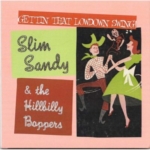 Slim Sandy & the Hillbilly Boppers – Getting that Low Down Swing
Slim Sandy & the Hillbilly Boppers – Getting that Low Down Swing
Crow-Matic Records 2017
Hug And Spank And Kiss – Hop Skip And Jump – Gettin’ That Lowdown Swing – Whoa Boy – No More Nothing – Be Bop A Lula – I Never See My Baby Alone – We’re Gonna Bop – Crawdad – Cadillac Model – Wow Wow Baby
This fine trio returns with another killer album. It kicks off with the Berry influenced “Hug, Spank and Kiss” written by Slim Sandy and featuring Eddy Cavalero (of the the Cavaleros, a band that also features German Ebert of the Hillblly Boppers on drums) on electric lead guitar. Back to a more acoustic sound with the Collins Kids’ “Hop Skip & Jump” with Willa Mae on lead vocals and harmonies by Slim. “Getting that Lowdown Swing” tales the listener back to the early western swing era (before the genre had a name). In the same vein you’ll find “Cadillac in Model A” and “No More Nothin'” both with Mike Sadava steel. He also plays on “I Never See My Baby Alone”. I always liked that one and the Hillbilly Boppers do great justice to that song.
There’s also a good dose of Hillbilly Bop with “Woah Boy” and “We’re Gonna Bop”.
Another good one is their cover of “Be-Bop-A-Lula.” It sounds like the Everly Brothers version but played by a skiffle band. More skiffle-billy follows with “Crawdad” that changes of pace in the middle and evolves into “Rollin’ My Sweet Baby’s Arms.”
Like the previous one it’s joyful and exuberant and it’s highly contagious.
Fred “Virgil” Turgis
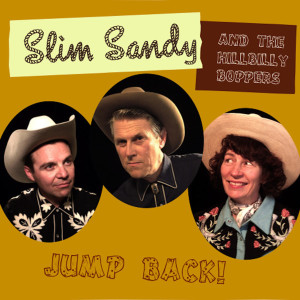
Slim Sandy & the Hillbilly Boppers – Jump Back!
Crow-Matic Records 2014
Jump Back, Love Me, Darlin’ Cory, I’m A Hog For You Baby, Jump Rope Boogie, n The Road Again, Pistol Boogie, Can’t Find The Doorknob, Cow Cow Boogie, Rock ‘n’ Roll Ruby, Rollin And Tumblin
Slim Sandy (Peter Sandmark) is a well known figure on the rocking scene. He drummed for Ray Condo, sang and played guitar in the Crazy Rhythm Daddies and released several albums as a one-man band. He now has a new band, the Hillbilly Boppers, with Willa Mae on washtub bass and harmony vocal and German Ebert on drums, Slim Sandy taking the lead vocals and playing harmonica and swingin’ guitar.
If you want to have a slight idea of the joyful noise made by this hot and fine trio, imagine a mix between the Delmore brothers, Jimmy and Johnny (thanks to Mae’s perfect harmony vocals ) played by a jug band (think Gus Cannon/Noah Lewis) with a swingin’ and a rockin’ edge and some skiffle elements and the fervor of some bluegrass gospels thrown in for good measure. It features eleven tracks lifted from the catalogs of Ella Fitzgerrald, Sun records, Jimmie and Johnny, Muddy Waters and everything good in between Not only the music and the songs are solid but this record also has a communicative « joie de vivre » that is sure to make you move your feet. Strongly recommended.
Fred “Virgil” Turgis
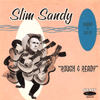
Slim Sandy – Rough & Ready
Sleazy Records SRCD09
Bow Legged Daddio-Cats Was A Jumpin’-Couldn’t Sleep Last Night-Flathead Ford-Slow Down Baby-No Gasoline-Mr. Guitar-Gettin’ By Jus’ The Same -Three Alley Cats-Party In Room 109
Here is a new short ten tracks Cd from the one-man band Slim Sandy for the spanish Sleazy Records. Slim is part of a today one-man trend with people like Bloodshot Bill, Scott H. Biram, Sheriff Perkins, The Legendary Tiger Man, Mark Sultan, Muskrat, Mr. Bonz, Urban Junior, Reverend Beat Man, The Fabulous Go-Go Boy and Rizorkestra just to name a few of them. But most of these guys are on the trashy side and are influenced more by Hasil Adkins or the sixties garage sounds than Doctor Ross or Harmonica Franck.
Slim with his guitar, harmonica, and suitcase drum is on the rockabilly, blues and hillbilly side. This album “Rough & Ready” with his eight self-penned songs and two covers (John Worthan’s “Cats Was a Jumpin’” and Roy Hall’s “Three Alley Cats” even if his “Flathead Ford” is very similar to Papa Lightfoot’s “Mean Old Train”) will delight the raw and primitive sound lovers. The last track “Party in Room 109” is a song Slim wrote based on the events that happened in room 109 at the Red Hot and Blue Rockabilly Weekender 2006. Don’t have to tell you that there were a lotta booze, yellin’ and savage rock’n’roll involved.
David “Long Tall” Phisel

Slim Sandy – This is Slim Sandy
Crow-Matic Records
Don’t Need Nuthin’ – 7 Nights To Rock – Come Back Baby – Bicycle Boogie – You Can’t Fool Me – Cabin By The Creek – California Blues – Down In Kokomo – The Way You Dance – Rock It All Night
This cd offers 10 cuts (three covers and seven originals) recorded live by Slim Sandy, the one man hillbilly blues band. Harmonica, guitar, drums and vocals all played in the same time by the same man. Slim Sandy’s inspiration goes from blues (Doctor Ross’ Come Back Baby) to hillbilly (a great rendition of Jimmie Rodgers’ California Blues with yodel) with a lot of Hasil Adkins and Rock’n’roll in between. Sandy’s own are great too and well written. Sure the sound is raw, but you don’t expect a one man band sounding like a Phil Spector production, do you? Believe me, you can’t go wrong with this guy !
Fred “Virgil” Turgis

